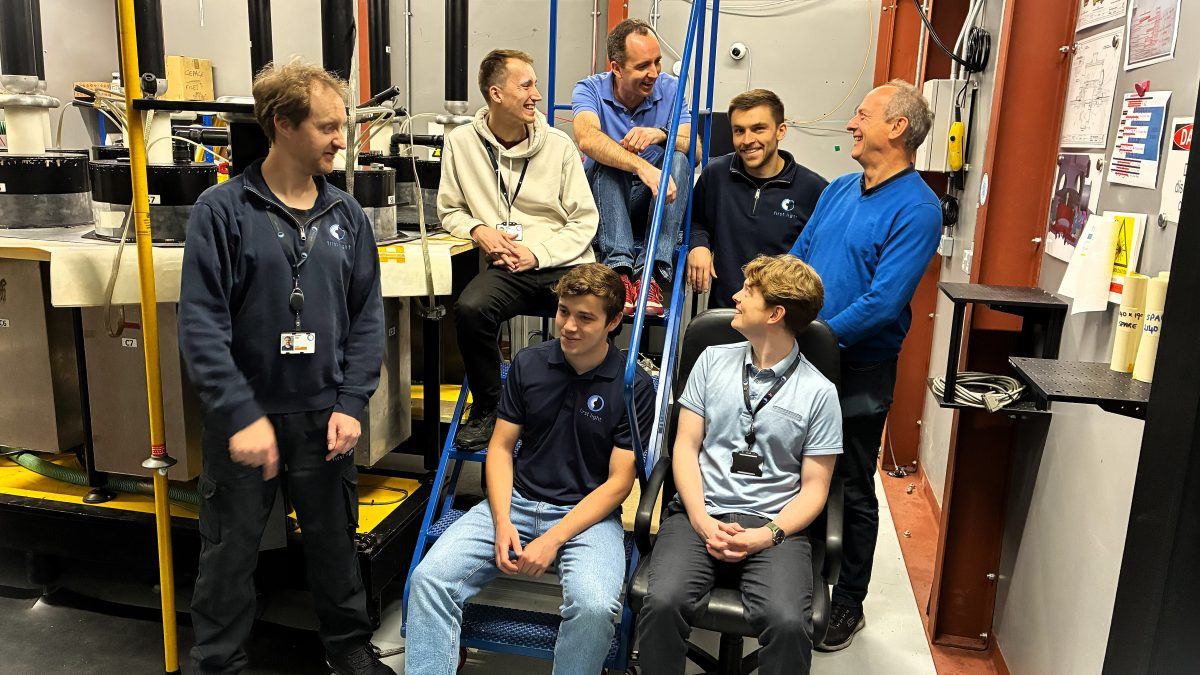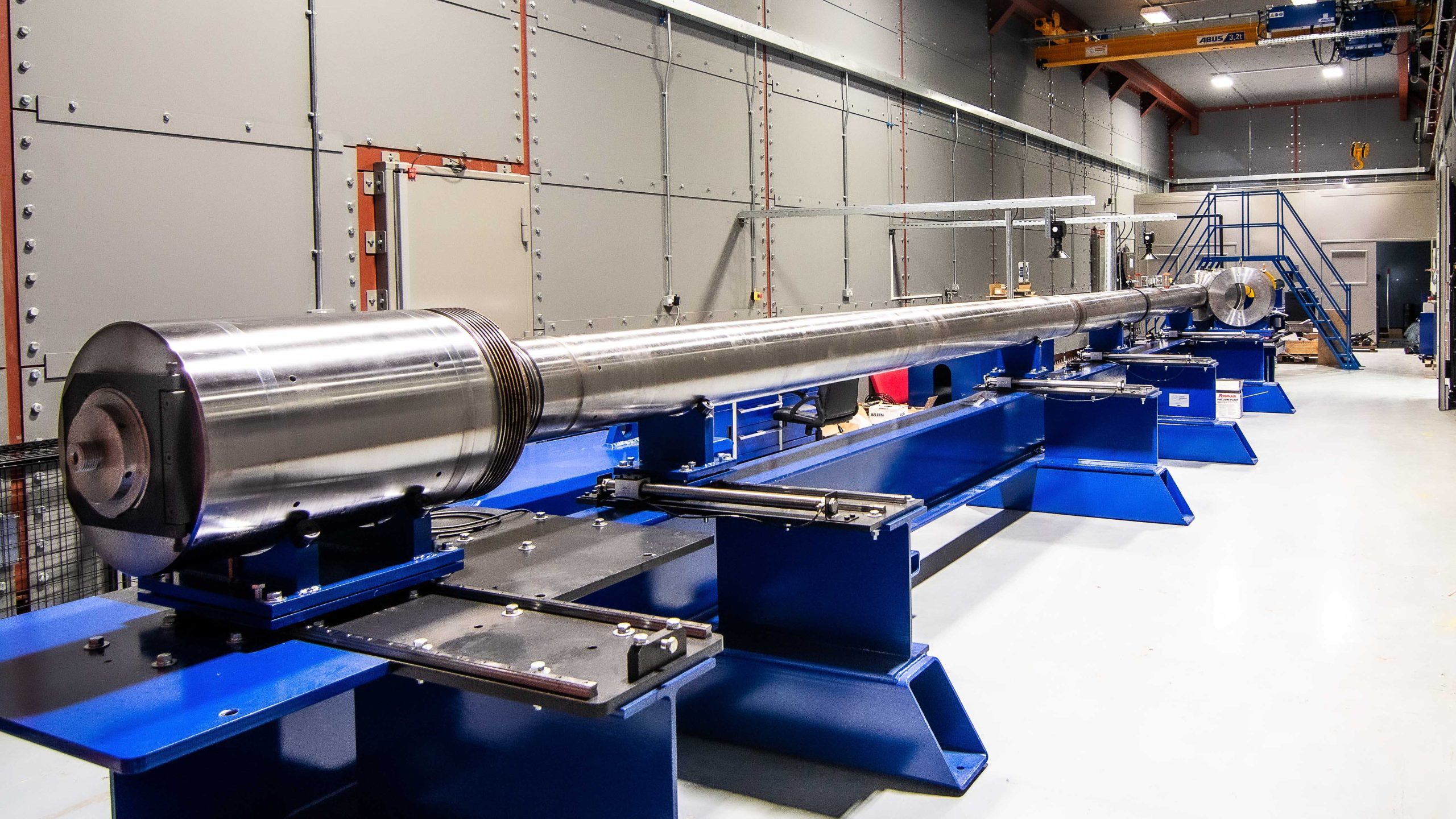Photo Caption: The team at FLF, lead by Hugo Doyle, Head of Empirical Validation, who completed the FIP project.
Oxford, UK – 11, November, 2025: A team at First Light Fusion (FLF) has successfully completed a feasibility study project awarded by the United Kingdom Atomic Energy Authority (UKAEA) Fusion Industry Programme to develop highly specialised sensors for extreme conditions of fusion energy environments.
Sixteen contracts were awarded between 13 organisations (10 private companies and three academic institutions) and each was tasked with developing a range of sensing and diagnostic technologies for use in extreme environments, an essential field of innovation for future fusion power plants.
FLF undertook a technical feasibility study, taking its sensing and diagnostics technologies to ‘proof of concept’ stages with support from the Fusion Industry Programme, for the project entitled ‘Prototyping a multi-use Photon Doppler Velocimetry (PDV) system for robust, remote measurement of inertial fusion compression, power plant relevant electron density measurements and vacuum chamber wall shock movement.’
First Light responded to the challenge as follows:
The Challenge: Peeking Inside a Fusion Reaction
Inertial Fusion Energy (IFE) involves squeezing atoms together at incredibly high speeds and temperatures. Scientists need to measure these speeds to understand how well the process is working. However, the environment inside a fusion reactor is extreme, with intense radiation and flying debris. Traditional measuring tools cannot survive in these conditions. The environment and containment around the fusion event itself also need to be monitored.
The Solution: A New Robust, Remote, Multi-measurement, Laser Speed Gauge
First Light Fusion proposed a multi-use, remote, robust Photon Doppler Velocimetry (PDV) system using a laser beam to measure the speed of objects, such as the capsule holding the fusion fuel. It works by:
• A laser beam reflecting off the moving object.
• The reflected light changes slightly due to the object’s speed.
• This change is analysed to determine the object’s velocity.
Benefits of the First Light Fusion PDV variant
• Remote and Safe: The laser beam can be aimed from a safe distance, away from the harsh environment inside the reactor.
• Fast and Accurate: PDV can measure speeds with incredible detail, helping scientists understand the fusion process better.
• Multi-purpose: This system can not only measure speed but also track changes in electron density around the target and the impact on the reactor walls.
• Robust: This project will develop methods to ensure survivability of this part – no human maintenance can occur within a working powerplant.
Testing and Development
The research team at FLF tested this PDV system using its large, pulsed power machines which recreated many of the harsh environments present in a fusion reactor.
The project demonstrated proof of concept measurements for this reactor diagnostic, measuring speeds from metres to kilometres per second. It also demonstrated a self-healing, liquid metal mirror to use as the final optic – an item of wider interest for other reactor measurements. This will allow First Light to further develop its fusion product portfolio.
Hugo Doyle, Head of Empirical Validation at First Light Fusion said:
“This project is an important step towards making fusion power a reality. By developing new diagnostic tools like PDV, scientists can gain valuable insights into the fusion process, paving the way for a clean and sustainable energy source for the future. We are commercialising this product for use in future fusion power plants and to support research on the journey.
“We wish to thank the UKAEA Fusion Industry Programme for funding this work and for having the foresight to establish the world leading effort to develop commercial reactor diagnostics, thinking beyond the development phase.”
Lyndsey Mooring, Head of the Fusion Industry Programme, UKAEA, added:
“Over the last four years the Fusion Industry Programme has placed £40m worth of R&D contracts into the fusion energy supply chain. With a goal of supporting R&D across all fusion concepts it has been inspiring to see FLF’s success with another FIP challenge project in such an important technical area.”
Nick Hawkes, Fusion Industry Programme Technical Advisor, UKAEA concluded:
“Diagnostics for the next generation of fusion devices are both a crucial need but also a huge challenge. The team at First Light Fusion has made great progress over the course of this project to take this technique and develop it into a solution that can be deployed in the harsh IFE environment.”
-END-
Notes To Editors:
About the United Kingdom Atomic Energy Authority
Who we are
The United Kingdom Atomic Energy Authority (UKAEA) is the UK’s national fusion energy research organisation. We are an executive non-departmental public body of the Department for Energy Security and Net Zero (DESNZ).
The work we do
UKAEA’s mission is to lead the delivery of sustainable fusion energy and maximise the scientific and economic benefit. We do this by being technical experts, partnering with companies and the international research community.
At the core of UKAEA’s efforts is the operation of world-leading facilities that build a comprehensive knowledge base for fusion energy. By addressing and solving the challenges across the full lifecycle of fusion, and integrating solutions from various disciplines, we establish technical centres of excellence that serve as the foundation for future fusion power plant programmes.
UKAEA collaborates with its partners to develop fusion power plants by providing access to our skills, facilities and expertise. UKAEA owns UK Industrial Fusion Solutions (UKIFS) on behalf of the UK government. Through UKIFS, we’re spearheading the Spherical Tokamak for Energy Production (STEP) programme to design and build the UK’s first prototype fusion energy power plant in Nottinghamshire.
To grow the fusion ecosystem, UKAEA focuses on cultivating skilled talent, growing the fusion industry and creating ‘innovation clusters’. We actively seek opportunities to advance fusion technologies and communicate its vast potential to stakeholders and the public alike to accelerate fusion energy’s future – the energy of tomorrow we need today.
More information: https://www.gov.uk/ukaea. Social Media: @UKAEAofficial



